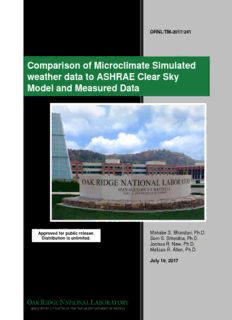
Comparison of Microclimate Simulated weather data to ASHRAE Clear Sky Model and Measured ... PDF
Preview Comparison of Microclimate Simulated weather data to ASHRAE Clear Sky Model and Measured ...
ORNL/TM-2017/241 Comparison of Microclimate Simulated weather data to ASHRAE Clear Sky Model and Measured Data Approved for public release. Mahabir S. Bhandari, Ph.D. Distribution is unlimited. Som S. Shrestha, Ph.D. Joshua R. New, Ph.D. Melissa R. Allen, Ph.D. July 19, 2017 DOCUMENT AVAILABILITY Reports produced after January 1, 1996, are generally available free via US Department of Energy (DOE) SciTech Connect. Website http://www.osti.gov/scitech/ Reports produced before January 1, 1996, may be purchased by members of the public from the following source: National Technical Information Service 5285 Port Royal Road Springfield, VA 22161 Telephone 703-605-6000 (1-800-553-6847) TDD 703-487-4639 Fax 703-605-6900 E-mail [email protected] Website http://www.ntis.gov/help/ordermethods.aspx Reports are available to DOE employees, DOE contractors, Energy Technology Data Exchange representatives, and International Nuclear Information System representatives from the following source: Office of Scientific and Technical Information PO Box 62 Oak Ridge, TN 37831 Telephone 865-576-8401 Fax 865-576-5728 E-mail [email protected] Website http://www.osti.gov/contact.html This report was prepared as an account of work sponsored by an agency of the United States Government. Neither the United States Government nor any agency thereof, nor any of their employees, makes any warranty, express or implied, or assumes any legal liability or responsibility for the accuracy, completeness, or usefulness of any information, apparatus, product, or process disclosed, or represents that its use would not infringe privately owned rights. Reference herein to any specific commercial product, process, or service by trade name, trademark, manufacturer, or otherwise, does not necessarily constitute or imply its endorsement, recommendation, or favoring by the United States Government or any agency thereof. The views and opinions of authors expressed herein do not necessarily state or reflect those of the United States Government or any agency thereof. ORNL/TM-2017/241 Energy and Transportation Sciences Division COMPARISON OF MICROCLIMATE SIMULATED WEATHER DATA TO ASHRAE CLEAR SKY MODEL AND MEASURED DATA Mahabir S. Bhandari Som S. Shrestha Joshua R. New Melissa R. Allen Date Published: July 19, 2017 Prepared by OAK RIDGE NATIONAL LABORATORY Oak Ridge, Tennessee 37831-6283 managed by UT-BATTELLE, LLC for the US DEPARTMENT OF ENERGY under contract DE-AC05-00OR22725 CONTENTS Page LIST OF FIGURES ...................................................................................................................................... v LIST OF TABLES ...................................................................................................................................... vii ACRONYMS ............................................................................................................................................... ix ABSTRACT ................................................................................................................................................ 11 1. INTRODUCTION .............................................................................................................................. 11 1.1 SIGNIFICANCE ....................................................................................................................... 11 1.2 MICROCLIMATE SIMULATION .......................................................................................... 12 2. DATA SOURCES .............................................................................................................................. 12 2.1 ASHRAE CLEAR SKY MODEL ............................................................................................ 12 2.2 WEATHER STATION ............................................................................................................. 13 2.3 MICROCLIMATE SIMULATION .......................................................................................... 14 3. RESULTS ........................................................................................................................................... 15 3.1 ENVI-MET VS. CLEAR SKY AND WEATHER DATA ....................................................... 15 3.2 WRF VS. MEASURED WEATHER DATA PRELIMINARY ANALYSIS .......................... 16 3.2.1 SHORT TERM COMPARISON OF MEASURED AND MODELED DATA .......... 16 3.3 WHOLE BUILDING ENERGY ANALYSIS .......................................................................... 21 4. CONCLUSIONS ................................................................................................................................ 24 REFERENCES ........................................................................................................................................... 25 iii LIST OF FIGURES Figure Page Figure 1. ASHRAE Clear Sky Model’s predicted maximum direct normal irradiance for ORNL for a day from each season assuming a clear sky. ......................................................................... 13 Figure 2. Weather station on the roof of ORNL’s two-story Flexible Research Platform (FRP2) captures all weather data needed to accurately model whole-building energy consumption. ........................................................................................................................... 13 Figure 3. Comparison between ACSM predicted and ENVI-met calculated direct normal irradiance for June 21, 2013 at the ORNL campus shows physically-unrealistic radiation levels and temporal shift. ................................................................................................................... 15 Figure 4. Comparison among ACSM predicted, measured, and ENVI- met calculated direct normal irradiance for Dec 21, 2013 at the ORNL campus shows little correlation between the simulated and actual solar irradiance. ..................................................................................... 15 Figure 5: Comparisons between WRF calculated (purple) and measured data (blue) for January 2015 at Oak Ridge, TN show the degree of agreement for Temperature, Relative Humidity, Barometric Pressure, Wind Speed, and Wind Direction. ....................................... 16 Figure 6. Rose diagram of wind speed and direction of measured (left) and WRF-simulated (right) allow qualitative comparison of differences. WRF-simulated wind speed tends to be 2- 3x stronger, has no calm events, and blows more omni-directionally..................................... 18 Figure 7. Box-and-whisker plots of hourly dry bulb, relative humidity, wind speed, direct normal irradiance (DNI), and diffuse horizontal irradiance (DHI) for each month shows the statistical differences between measured and simulated weather variables. Lines show the maximum and minimum value, where vertical bars meet is the average monthly data value, bars show the 25–50th percentile and 50–75th percentile of hourly data for that month. Charts for DNI, and DHI show data for daylight hours only. .............................. 19 Figure 8: Frequency distribution of values within specific weather variables. ........................................... 19 Figure 9: Frequency distribution of values within specific weather variables. ........................................... 20 Figure 10 : Heating and cooling degree days .............................................................................................. 20 Figure 11: EnergyPlus model of buildings: (a) Building 1, (b) Building 2 and (c) Building 3 ................. 21 Figure 12 : Monthly Heating and cooling loads.......................................................................................... 22 Figure 13 : Annual energy consumption using measured weather data as well where individual parameters from Set 1 are used to replace the measured weather data for variables including: dry bulb temperature (DB), relative humidity (RH), direct normal irradiance (DNI), diffuse horizontal irradiance (DHI)and wind speed (WS). .......................................... 23 v LIST OF TABLES Table Page Table 1. The hardware and sensors used in this study to measure individual weather parameters that are most important for accurate whole-building energy simulation. ....................................... 14 Table 2. WRF’s nested grid sizes used for modeling microclimate of ORNL. Each of these domains used “Single Moment 3-class” Microphysics, “New Goddard” Radiation, “Xu-Randall” Cloud Fraction, “Morin-Obukhov” Surface Physics, “Noah” Land, and “BouLac” Planetary Boundary Layer whereas Cumulus and Urban Parameters varied. ......................... 14 Table 3. Statistical summary of measured and WRF (Set1) 270m hourly weather data for major weather variables during 2015. This data could be used to prioritize or correct bias between measured and simulated data. ................................................................................... 17 Table 4. Variation in annual energy consumption with respect to weather data ........................................ 22 vii
Description: